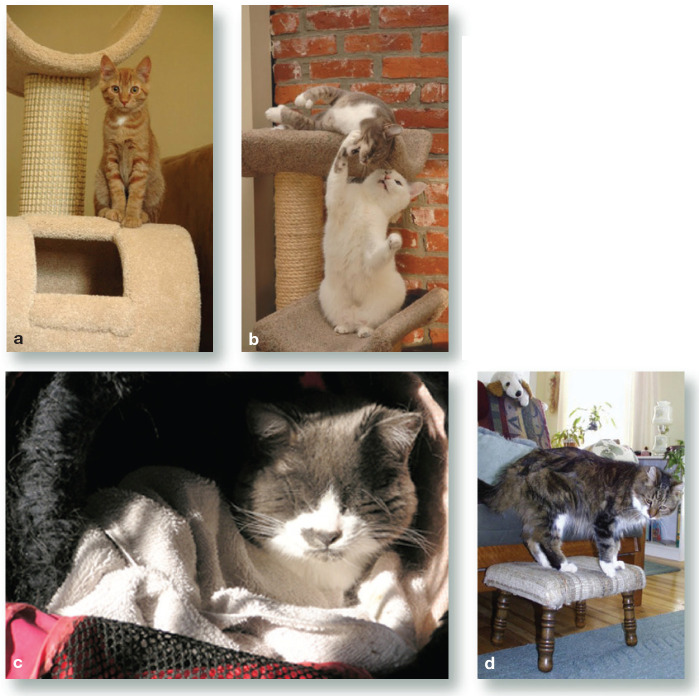Abstract
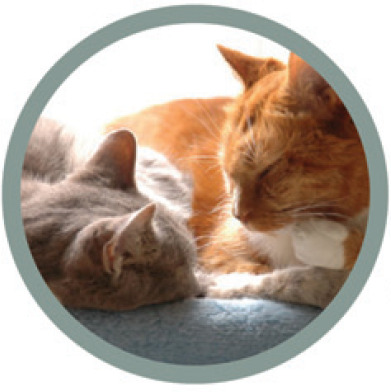
Background and goals Cats have become the most popular pet in the United States, yet statistics about veterinary care for cats remain troubling. 1 Although most owners consider their cats to be family members, cats are substantially underserved, compared with dogs. In 2006, owners took their dogs to veterinarians more than twice as often as cats, averaging 2.3 times/year, compared with 1.1 times/year for cats, and significantly more dogs (58%) than cats (28%) were seen by a veterinarian one or more times/year. 2 Cat owners often express a belief that cats ‘do not need medical care’. Two reasons for this misconception are that signs of illness are often difficult to detect, and cats are perceived to be self-sufficient. 2 One role of the veterinarian is to develop a partnership with cat owners that will pave the way for a lifelong health care plan. These guidelines aim to outline an evidence-based life stage wellness program to aid the veterinary medical team in delivering the best comprehensive care for cats. Specific goals are to provide:
Recommendations for optimal health care for cats throughout the different life stages.
Practical suggestions and tools to facilitate improved veterinary visits and to enhance the client-veterinarian clinical encounter.
A foundation from which to access sources of additional information.
Life stage classification Distinct life stages (age groups) in cats are not well defined, in part because individual animals and body systems age at different rates, a process that is influenced by many factors. These guidelines follow one convenient classification (see box below). These age designations help to focus attention on the physical and behavioral changes that occur at different stages (eg, congenital defects in kittens, obesity prevention in the junior cat). It must be recognized, however, that any age groupings are inevitably arbitrary demarcations along a spectrum, and not absolutes.
Evidence-based health care Supporting references for specific recommendations are supplied where possible, and any previously published guidelines on particular topics are referred to where relevant. Readers should note, however, that the guidelines panel was hampered in its efforts by the relative paucity of disease incidence data by age group that is available, and there is an urgent need for research to guide the future of evidence-based feline health care. 3
Getting Started: The Wellness Exam
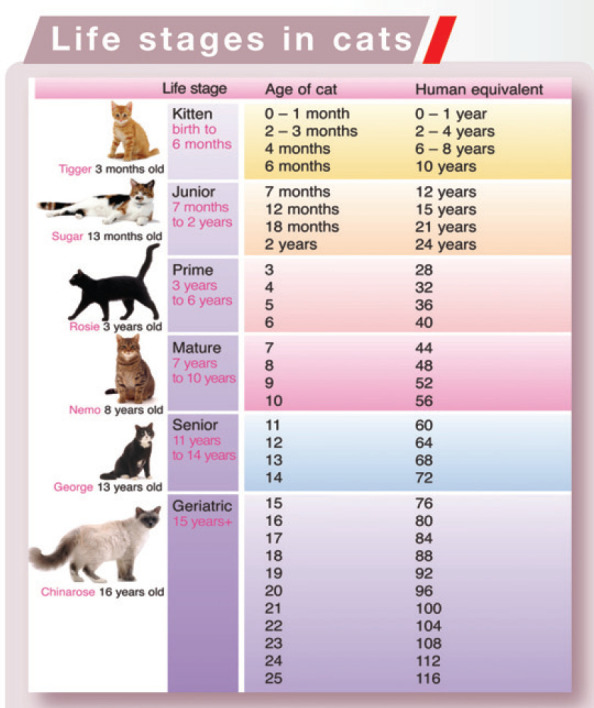
To achieve optimum feline health care, veterinarians must help owners to understand and appreciate the importance of regular preventive care for their cats at all ages. A consistent message from the entire health care team is crucial, beginning with the first kitten visit and reinforced during subsequent visits. Early detection of clinical abnormalities and behavioral changes can improve disease management and quality of life.5,5
How Frequent?
The panel supports the recommendations of the American Association of Feline Practitioners (AAFP) and American Animal Hospital Association (AAHA) that a minimum of annual wellness examinations and consultations for all cats is justifiable. More frequent examinations may be recommended for seniors and geriatrics, and cats with medical and behavioral conditions.
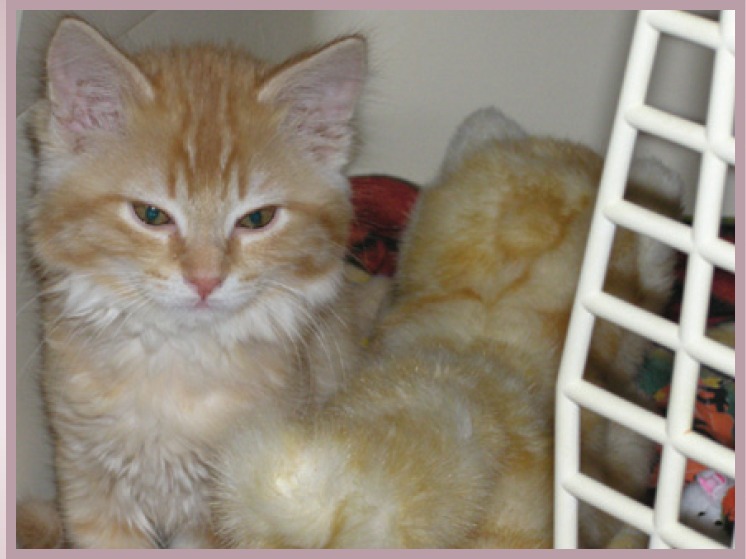
Life Stages in Cats
The AAFP and AAHA welcome endorsement of these guidelines from the European Society of Feline Medicine, and acknowledge the help of the Feline Advisory Bureau's WellCat for Life programme in helping to formulate the guidance.
A minimum of annual wellness examinations and consultations for all cats is justifiable. Semi-annual wellness exams are often recommended for all feline life stages by veterinarians and veterinary organizations.
Semi-annual wellness exams are often recommended for all feline life stages by veterinarians and veterinary organizations. Their reasoning includes the fact that changes in health status may occur in a short period of time; that ill cats often show no signs of disease; and that earlier detection of ill health, body weight changes, dental disease, and so on, allows for earlier intervention. In addition, semi-annual exams allow for more frequent communication with the owner regarding behavioral and attitudinal changes, and education about preventive health care. Further research is needed to identify the optimal examination schedule to maximize the health and longevity of the cat.
The panel members concluded that preventive veterinary care can improve quality of life, detect illness earlier and, therefore, reduce the long term expenses associated with a cat 's health care. They believe that cat owners are willing to seek more veterinary care when it improves quality of life and detects illnesses earlier, thereby reducing the long term expenses associated with their cat 's health care. Improved client communication and education of the benefits of regular veterinary care are essential to achieve that goal (Fig 1).
Fig 1.
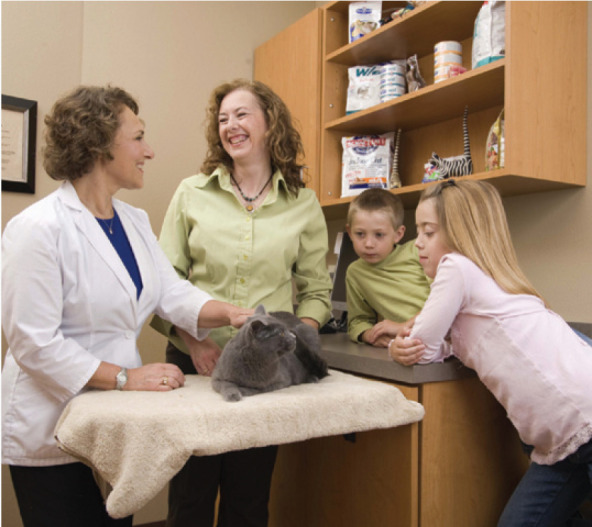
The benefits of regular wellness exams often are not immediately apparent to pet owners and need to be well explained. Courtesy of Ilona Rodan
The reasons pet owners have cited for not seeking care were that they did not know it was necessary, the veterinarian did not recommend it, and the need or benefit was not well explained. 7 Other obstacles include the cat 's stress or fear associated with veterinary visits and the practical difficulties of transporting cats to receive veterinary care. Suggestions for overcoming such barriers are provided on page 45.
History-Taking
It is not the intent of the panel to reiterate the basics of the veterinary visit, but instead to offer a checklist to assist the veterinarian (see Table 1). Where relevant, aspects of feline behavior, nutrition, and various disease prevention and detection strategies are expanded on in the text.
Table 1.
Wellness visit: discussion and action items
| General discussion/action items | Specific discussion/action items | ||||||||||
|---|---|---|---|---|---|---|---|---|---|---|---|
| ALL AGES | KITTEN | JUNIOR | ADULT | MATURE | SENIOR | GERIATRIC | |||||
| (0–6 m) | (7 m-2 y) | (3–6 y) | (7–10 y) | (11–14 y) | (15+ y) | ||||||
|
|
This age group is often overlooked and would benefit from regular veterinary care | Specific management of mature and older cats is described in the AAFP Senior Care Guidelines 5 and AAHA Senior Care Guidelines for Dogs and Cats 18 | ||||||||
| Behavior and environment* |
|
|
|
|
Increased importance of good/easy accessibility to litter box, bed, food |
|
|
||||
| Medical/surgical history; sterilization |
|
Discuss sterilization, including pros and cons of surgery at different ages |
|
Discuss baseline adult data to assess subsequent changes (weight, BCS, MDB, etc)* |
|
Increase focus on mobility, duration and/or progression of any specific signs | Increasing importance for regular review of medications and supplements | ||||
| Elimination* |
|
Litter box set-up, cleaning and normal elimination behaviour 10 | Confirm that litter box size accommodates growing cat | Review the size and edge height of litter box to ensure the cat can enter easily as it ages | Adjust litter box size, height and cleaning regimes as necessary | Nutrition and weight management* |
|
Monitor for weight changes and feed to moderate body condition. (Caloric needs decrease after sterilization and increase in breeding females) | Feed to moderate body condition. Monitor for weight changes and modify food intake accordingly | Feed to moderate body condition. Monitor food intake and BCS/weight changes | |
| Oral health* |
|
|

|

|
|||||||
|
|||||||||||
| Parasite control* |
|
Deworming every 2 weeks from 3–9 weeks of age; then monthly until 6 months of age. Fecal exams 2–4 times during the first year of life | Continue fecal exams 1–4 times/year depending on health and lifestyle factors | Conduct fecal exams 1–2 times/year, depending on health and lifestyle factors | |||||||
| Vaccination21,21 |
|
FeLV vaccine highly recommended for kittens due to unknown future lifestyle. Review, complete, continue vaccination series | Review, complete, continue vaccination series. Review vaccine history/viral screening | Continue core vaccines as per current guidelines. Evaluate risk assessment and use of non-core vaccines, if indicated, as per current guidelines | |||||||
See text discussion. m = months, y = years, BCS = body condition score, MDB = minimum database, See text discussion. m = months, y = years, BCS = body condition score
History-taking includes the use of open-ended questioning (eg, ‘How has [cat 's name] been doing since the last visit?’). 8 This approach is often combined with a template or checklist, such as given in Table 1, to ensure important aspects are not overlooked.
Physical Examination
When performing the physical exam, particular attention should be paid to:
Observing the cat from a distance to assess breathing patterns, gait, stance, strength, coordination and vision.
Changes in parameters from prior exams (body weight, body condition score [BCS], vital signs).
Other specifics as noted in the discussion/ action items in Table 1.
Identification
According to one study, 41% of people looking for their lost cats considered them to be indoor-only pets. 9 American Humane Association records reveal that only about 2% of lost cats ever find their way back from shelters, a major reason being the lack of tag or microchip identification. Assuring the identification of all pet cats, regardless of their lifestyle, is recommended to increase the prospect of lost cats being returned to their owners. The wellness examination is the ideal time to discuss the importance of identification with owners. The benefits of both visible (eg, collar and tag) and permanent (microchip) identification should be explained and compliance with identification recorded in the medical records along with other elements of the history.
The Minimum Database
Although specific data documenting benefits are not available, the panel concluded that regular wellness examinations and collection of the minimum database (MDB; Table 2) can be valuable, allowing early detection of disease or trends in clinical or laboratory parameters that may be of concern. Additionally, it provides a baseline for interpretation of data recorded at subsequent visits.
Table 2.
The minimum database by age group
| Kitten/junior | Adult | Mature | Senior/geriatric | |
|---|---|---|---|---|
| CBC | +/- | +/- | + | + |
| Hematocrit, RBC, WBC, differential count, cytology, platelets | ||||
| CHEM screen | +/- | +/- | + | + |
| As a minimum include: TP, albumin, globulin, ALP, ALT, glucose, BUN, creatinine, K+, phos, Na+, Ca2+ | ||||
| Urinalysis * | +/- | +/- | + | + |
| Specific gradient, sediment, glucose, ketones, bilirubin, protein 23 | ||||
| T4 * | +/- | + | ||
| Blood pressure * | +/- | +/- | + | |
| Retroviral testing | + | +/- | +/- | +/- |
| Fecal examination * | + | + | + | + |
See text discussion. CBC = complete blood count, RBC = red blood cells, WBC = white blood cells, CHEM = chemistry, TP = total protein, ALP = alkaline phosphatase, ALT = alanine aminotransferase, BUN = blood urea nitrogen, T4 = thyroxine
Overcoming Barriers to Veterinary Visits
The panel recommends that the veterinary team endeavours to make the veterinary encounter comfortable for both cat and client. Integral to this is a better understanding of feline behavior.10,10 Some specific tips to help minimize the challenges associated with bringing a cat to the clinic are given below.
Once the client arrives at the veterinary clinic, the health-care team can take steps to reduce stress for both the client and the cat, as is feasible for their situation. 12 See below for some ideas for the waiting client and cat, and some tips to facilitate examination and treatment.
Reducing the Stress of Transport
-
Socialize kittens to the carrier and to travelling:
-
–
Keep the transport carrier out and accessible in the home.
-
–
Create and maintain a positive association with the transport carrier by making it a comfortable resting, feeding or play location.
-
–
When feasible, and if the cat is neutral or favorably inclined to car travel, encourage owners to take the cat on periodic car rides paired with positive experiences.
-
–
Withholding food prior to travel may prevent motion sickness, increase interest in treats at the clinic, and is beneficial if blood is to be collected.
Apply a calming synthetic pheromone to, and/or place familiar clothing from a favorite person in, the carrier on a routine basis and just prior to transport.13,13
-
–
Provide cover/hiding options in or over carrier (eg, blanket draped over carrier) during transport.

Supplementary Data
An AAFP position statement entitled ‘Respectful handling of cats to prevent fear and pain’ is available at www.catvets.com and included in the online version of this article at doi:10.1016/j.jfms. 2009.12.006
Making the Cat and Client Comfortable at the Clinic
Provide a separate waiting room for cats, or ensure their immediate placement into an exam room.
Minimize waiting times.
Provide elevated platforms in the waiting area so owners can place cat carriers out of reach of dogs.
Use calming synthetic pheromones in the environment. 14
Facilitating the Examination and Treatment
-
Provide a cat-friendly exam room:
-
–
Keep the room and table warm, with a non-slip surface for the cat.
-
–
Avoid loud noises or ambient sounds that may mimic hissing (eg, whispering).
-
–
Distract and reward with tasty treats/catnip/play.
-
–
-
Handle using minimal restraint:
-
–
See AAFP Feline Behavior Guidelines for tips on handling cats during the veterinary examination. 10
-
–
While gathering historical information, allow the cat time to adjust to the surroundings by removing the top or opening the door of the carrier. The cat should ideally remain in the bottom half of the carrier for as much of the exam as possible; this allows it to adjust to the examiner and the environment.15,15
-
–
Allow the cat to hide partially under a towel; use towels, rather than scruffing, for handling where additional restraint is needed.
-
–
Avoid making eye contact with the cat.
-
–
Determine the most comfortable position for the cat during the examination, such as the veterinarian 's lap.
-
–
Use sedation, anesthesia or analgesics as indicated to reduce stress and/or pain.
-
–
Keep hospitalized cats away from dogs and out of visual range of other cats. 17
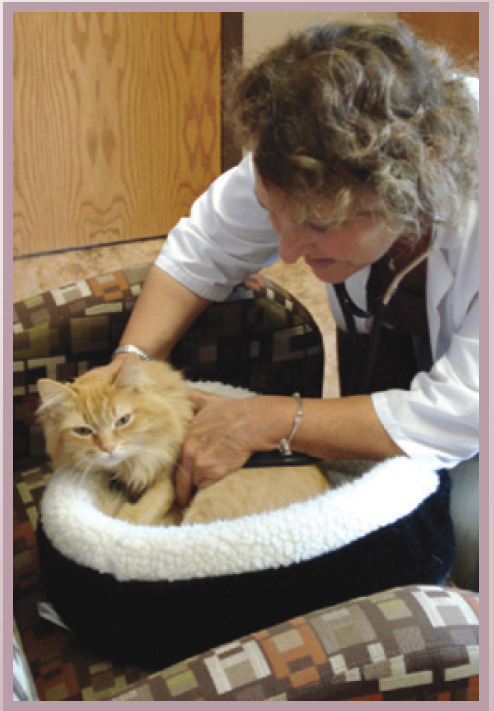
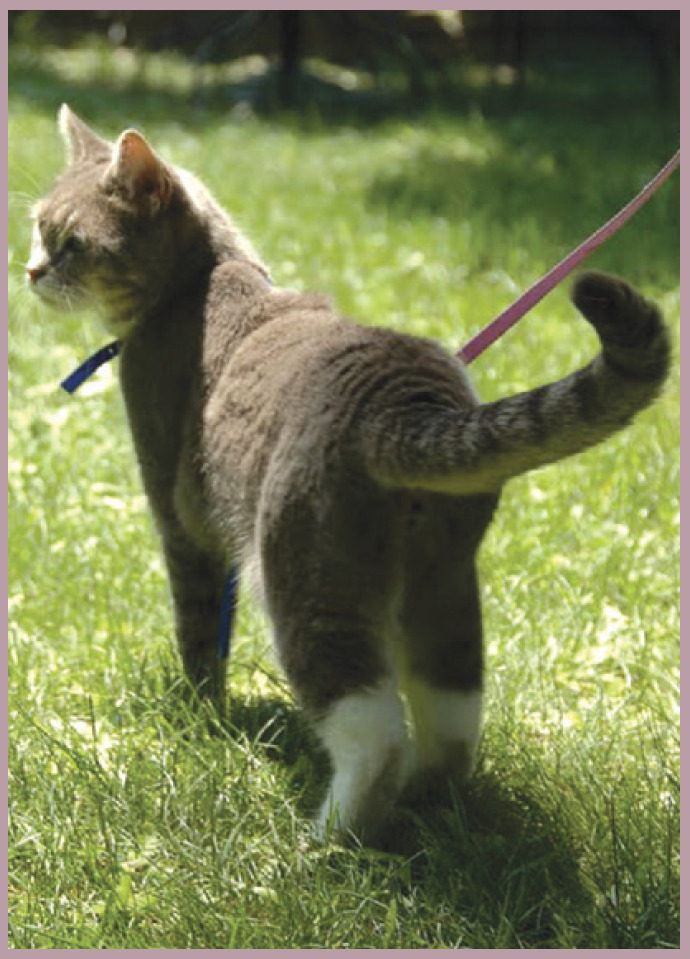
Specific recommendations about age and frequency of laboratory testing depend on many factors.5,18,24 One consideration in determining this frequency is that the incidence of many diseases increases as cats age. Guidelines for management of mature, senior and geriatric cats may be found in the AAFP Senior Guidelines. 5 Retroviral testing is discussed in detail in the AAFP Retrovirus Testing Guidelines. 22 Measurement of blood pressure is discussed in detail in the ACVIM guidelines. 25 Although limited incidence studies have been performed to identify the age of onset of hyperthyroidism in cats, the panel recommends that veterinarians strongly consider T4 testing in the apparently healthy mature cat. More robust incidence data is needed to develop firmer recommendations.
Nutrition and Weight Management
Diet Basics
Energy and nutrient needs vary with life stage, sterilization status and activity, and so general feeding recommendations provide only a starting point. Individual intakes must then be adjusted to maintain the desired weight and body condition score (Fig 2).
Fig 2.
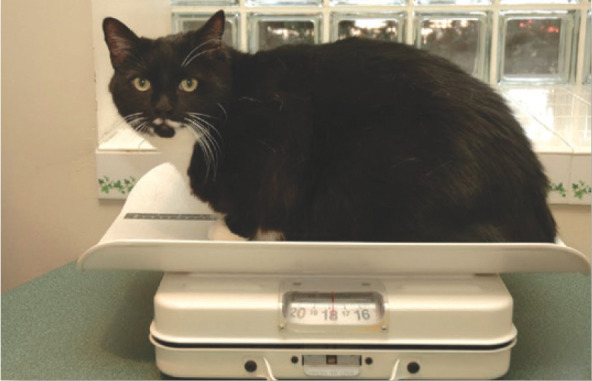
Regular assessment of weight and body condition score is important in cats of all ages — and this needs to be stressed to owners. Expressing any changes in weight as a percentage, or in terms of an equivalent weight loss/gain in humans, can be helpful. Courtsey of Deb Givin
Satisfactory diets for cats contain all the required nutrients in proper balance, are palatable and digestible, and are free of spoilage and contaminants. The specific source of nutrients in feline diets is irrelevant when these criteria are satisfied. 26 Both canned and dry food have been found to support health during all life stages. 27 The presence of a label guarantee that the food was tested using feeding trials provides the current best initial evidence that a diet is satisfactory.
The panel examined published peer-reviewed evidence-based studies in healthy, client-owned cats for any significant health effect of: feeding canned versus dry food (including contribution to dental health); providing a variety of foods versus a consistent diet; feeding high protein, low carbohydrate versus lower calorie and high fiber diets; feeding raw diets; providing dietary supplements, or access to grass or plants. Based on the available data, specific recommendations in favor of any of these practices cannot be made.
Despite the concern surrounding the effects of carbohydrate in dry foods, current evidence suggests that housing and activity (which may be a marker of welfare) 28 are more significant predictors of health.29–32 Evidence does not support the carbohydrate content of foods as being harmful or an independent risk factor for diseases such as obesity or diabetes.29,29
Cat owners are willing to seek more veterinary care when it improves quality of life and detects illnesses earlier, thereby reducing the long term expenses associated with their cat 's health care.
With regard to home-made foods, the veterinarian should discuss and share evidence about nutritional balance, risks associated with preparation and feeding of foods raw, and advantages of using food formulated for cats, referring clients to additional resources if required (Table 3).
Table 3.
Web resources for feline health care
| Veterinarian/clinic | Clients/pet owners | ||
|---|---|---|---|
| General wellness information | |||
| Feline Advisory Bureau (FAB) WellCat for life downloads: Veterinary Handbook | www.fabcats.org/wellcat/publications/index.php | ✓ | |
| Wellcat Log | www.fabcats.org/wellcat/owners/index.php | ✓ | |
| Morris Animal Foundation ‘Happy Healthy Cat Campaign’ | www.research4cats.org/ | ✓ | |
| Veterinary Partner | www.veterinarypartner.com | ✓ | |
| CATalyst Council | www.catalystcouncil.org/ | ✓ | |
| AAHA Compliance Study 7 | www.aahanet.org | ✓ | |
| Veterinary Information Network | www.vin.com | ✓ | |
| Behavior, environment and the veterinary encounter | |||
| Cornell Feline Health Center videos and health information | www.vet.cornell.edu/FHC/ | ✓ | ✓ |
| The Ohio State University Indoor Cat Initiative | www.vet.osu.edu/indoorcat.htm | ✓ | ✓ |
| Humane Society of The United States — indoor cats | www.hsus.org/pets/pet_care/cat_care/keeping_your_cat_happy_indoors.html | ✓ | ✓ |
| AAFP Feline Behavior Guidelines (also includes feeding tips) | www.catvets.com/professionals/guidelines/publications/?Id=177 | ✓ | |
| FAB information and Cat Friendly Practice Scheme: The Cat Friendly Home | www.fabcats.org/behaviour/cat_friendly_home/info.html | ✓ | |
| Bringing your Cat to the Vet | www.fabcats.org/catfriendlypractice/leaflets/vets.pdf | ✓ | |
| Creating a Cat Friendly Practice, Cat Friendly Practice 2 | www.fabcats.org/catfriendlypractice/guides.html | ✓ | |
| Dumb Friends League ‘Play with Your Cat’ | www.ddfl.org/behavior/catplay.pdf | ✓ | |
| Nutrition and diet | |||
| Your Cat 's Nutritional Needs — A Science-Based Guide for Pet Owners | http://dels.nas.edu/dels/rpt_briefs/cat_nutrition_final.pdf | ✓ | |
| American College of Veterinary Nutrition — links to nutrition information websites | www.acvn.org/site/view/58669_Links.pml;jsessionid=20s028q8i1ewt | ✓ | |
| Medical/dental care | |||
| AAFP Vaccination Guidelines | www.catvets.com/professionals/guidelines/publications/?Id=176 | ✓ | |
| European Advisory Board on Cat Diseases (ABCD) infectious diseases guidelines | www.abcd-vets.org | ✓ | |
| AAFP Zoonoses Guidelines | www.catvets.com/professionals/guidelines/publications/?Id=181 | ✓ | |
| AAFP Retrovirus Testing Guidelines | www.catvets.com/professionals/guidelines/publications/?Id=178 | ✓ | |
| AAFP Bartonella Panel Report | www.catvets.com/professionals/guidelines/publications/?Id=175 | ✓ | |
| AAFP Senior Care Guidelines | www.catvets.com/professionals/guidelines/publications/?Id=398 | ✓ | |
| AAHA Senior Care Guidelines for Dogs and Cats | http://secure.aahanet.org/eweb/dynamicpage.aspx?site=resources&webcode=SeniorCareGuidelines | ✓ | |
| AAHA Dental Care Guidelines for Dogs and Cats | http://secure.aahanet.org/eweb/dynamicpage.aspx?site=resources&webcode=DentalCareGuidelines | ✓ | |
| Veterinary Oral Health Council | www.vohc.org/ | ✓ | ✓ |
| AAHA-AAFP Pain Management Guidelines for Dogs & Cats | www.aahanet.org/PublicDocuments/PainManagementGuidelines.pdf | ✓ | |
| www.catvets.com/professionals/guidelines/publications/?Id=174 | ✓ | ||
| International Veterinary Academy of Pain Management | www.ivapm.org | ✓ | |
| Veterinary Anesthesia & Analgesia Support Group | www.vasg.org | ✓ | |
| Parasite prevention | |||
| Companion Animal Parasite Council: Information for veterinary and medical professionals | www.capcvet.org | ✓ | |
| Information for cat owners | www.petsandparasites.org/cat-owners/ | ✓ | |
| Centers for Disease Control and Prevention (CDC) zoonoses information | www.cdc.gov/ncidod/dpd/animals.htm | ✓ | |
| American Heartworm Society | www.heartwormsociety.org/ | ✓ | ✓ |
Feeding Regimens
A variety of feeding styles can maintain good health in client-owned cats, including free choice or provision of meals. In addition to monitoring intake, considerations include:
Providing water via bowls, dripping faucets and/or fountains, to promote adequate intake. When increased water intake is desirable, feeding of canned foods may help achieve this.
Locating food in a quiet area, especially for nervous or fearful cats (eg, away from other animals or household items that may make noises intermittently). 34
Offering dry foods in foraging devices (eg, food balls or puzzles), 35 and in multiple small meals in several widely dispersed bowls to slow intake and increase mental and physical activity.
Weight Management
Obesity may occur at any age, but is most commonly encountered in middle age.32,32 The risk of obesity may be reduced by environmental enrichment, increasing opportunities for activity, and individualizing food intake. The energy density of cat foods varies widely, based on the moisture and fat content of the diet. This information should be helpful in determining a guideline of how much to feed.
Tips and items for discussion with clients include:
Slowly (<10% increments and decrements) adjust calorie intake to life stage and conditions (eg, sterilization, indoor housing).
Provide environmental enrichment to increase activity. 35
Switch to a diet with lower energy density (reduced fat, increased air, fiber and/or moisture).
Change the feeding strategy.
Switch to meal feeding, with portion control.
Introduce foraging devices (see above).
Introduce barriers to food access (eg, baby gates, elevated feeding stations).
Factors to Consider When Changing the Diet
Provide amounts of the new diet equivalent to previous energy (versus volume) intake, adjusting the initial amount as needed to maintain moderate body condition.
Consider offering the new diet as a choice in the presence of the usual diet to enhance acceptability, and make diet changes gradually to minimize the risk of gastrointestinal upset in cats with a history of this response to dietary change.
Warm the food to body temperature; adding fish/clam juice may increase palatability for cats with a depressed appetite.
Appropriate environmental enrichment is essential for maintaining the mental and physical well-being of cats.
Behavior and Environment
An outline of behavior and environmental items for discussion at each life stage is presented in Table 1. The following discussion elaborates on those items, where applicable. For detailed recommendations about normal cat behavior and management refer to the AAFP Feline Behavior Guidelines. 10
All Ages
Provide plentiful resources — hiding spots, elevated resting spots, food, water, scratching posts and litter boxes — throughout the home, particularly for cats kept indoors and in multi-cat households (Fig 3).
Controversy exists over whether cats should be kept indoors-only or in an indoor/outdoor environment (see box below). These debates reflect geographical and cultural differences, as well as individual owner preferences.30,37–41 They underline the importance of providing an appropriate and stimulating environment for the cat. 35
Fig 3.
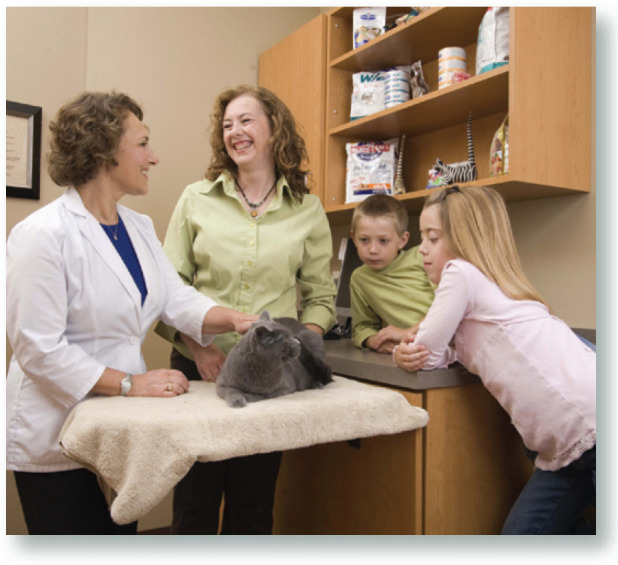
Environmental needs change with life stage, although environmental enrichment and adequate resource allocation remain important for all cats. While play and play items are a priority for the kitten and junior (a and b), easy access to a soft bed (c) and a comfortable resting spot, such as a sofa (d), assumes more importance in the senior and geriatric cat. Pictures (a), (b) and (d) courtesy of Deb Givin; (c) courtesy of Ilona Rodan
Lifestyle Choices
Indoor-only An indoor-only lifestyle may decrease the risks of trauma and certain infectious diseases and increase longevity, but may also increase the risks of compromised welfare and illness due to environmental limitations. Appropriate environmental enrichment is thus essential for maintaining the mental and physical well-being of cats.10,42–44
Indoor/outdoor An indoor/ outdoor lifestyle may provide a more natural and stimulating environment for cats, but may also increase the risks of infectious disease and trauma, and result in increased predation on wildlife. Supervised or controlled outdoor access, for example via leashed walks or cat-proof enclosures, may reduce some of the risks otherwise associated with access to the outdoors, and has been recommended by the AAFP and others.10,40,44
Kitten
Play Kittens have a high play drive; inter-cat social play peaks at about 12 weeks of age, 45 then object play becomes prevalent. Toys offer an outlet for normal predatory sequences as part of play, and help prevent play biting.
Litter boxes Litter box set-up and cleaning is critical for box usage. Although individual preferences can vary, most cats prefer clumping litter 46 and a clean box in an accessible but not busy location. Initially, kittens can be simultaneously offered a variety of litter box options to permit them to express personal preference through usage. Some cats may find scented litters aversive. 47
Socialization/handling Kittens should be gradually and positively acclimated as early as possible to any stimuli or handling techniques that owners plan them to encounter during their lifetime (eg, children, dogs, nail trims, tooth and coat brushing, car transport). This can be accomplished with food or other appropriate rewards, avoiding interactive punishment as it may elicit defensive aggression.
Junior
Inter-cat relations The reduction in social play combined with the dispersal effect (when free-living offspring leave the family unit at about 1–2 years of age) means that inter-cat aggression may develop at this stage of life.
Litter boxes and elimination Litter box rejection can stem from a variety of causes including litter type, box cleaning, box style, and box size. Cats have shown a tendency to prefer larger boxes.48,48
Urine marking Most intact cats and about 10% of sterilized cats mark their territory with urine. 50 The onset of this behaviour can coincide with sexual maturity.
Adult and Mature
Play Declining play activity increases susceptibility to weight gain. In one study, three 10–15 min exercise sessions per day caused a loss of approximately 1% of body weight in 1 month with no food intake restrictions. 51
Senior and Geriatric
Senior and geriatric cats exhibiting behavioral changes (eg, vocalization, changes in litter box usage) should always be evaluated for an underlying medical problem. 5
Parasites
Parasite control is important in cats of all ages. Prevention includes both animal and environmental control. The Companion Animal Parasite Council (CAPC) guidelines contain recommendations about prevention of ecto- and endoparasites, fecal testing, and more. 20 The United States Centers for Disease Control and Prevention website (see Table 3) also provides information on a variety of zoonoses. Items for discussion are listed in Table 1, and a few specifics are expanded on below.
Kittens
Because prenatal infection does not occur in kittens, roundworm treatment given every 2 weeks can start at 3 weeks of age. Kittens may begin receiving a monthly general endoparasite preventive at 8–9 weeks of age. 20
Heartworm: Key Points
Although the incidence in cats is lower than it is in dogs (10–15% of the rate in dogs), both indoor and outdoor cats are at risk of heartworm infection.
Infection with even a small number of adult worms can cause severe disease.
Signs differ from those in dogs, tending to be non-specific.
A combination of antigen and antibody testing increases the probability of an accurate diagnosis.
Adulticide treatment is currently not recommended for cats. There is no evidence that it improves survival in infected cats, and the death of adult worms can be life-threatening.
Monthly prophylaxis is both safe and effective. Some heartworm preventives also provide control of other parasites.
Clients face a potentially overwhelming amount of information at each visit to the veterinarian, so effective communication is essential.
All Life Stages
Feces testing allows monitoring of compliance with preventive medication as well as diagnosis of some endoparasites not treated by broad-spectrum preventives.
Heartworm presents a risk at all life stages in endemic areas. 52 Some points of note are listed in the box on page 51; additional details may be found on the websites of the CAPC and American Heartworm Society (see table 3).
Vaccination
Table 1 outlines the vaccination priorities to consider when designing a comprehensive, life stage-targeted wellness plan for a cat.
Dental Care
Diseases of the oral cavity are extremely common, 53 yet most owners are unaware that dental disease can threaten the health and welfare of their cat. The AAHA Dental Care Guidelines for Dogs and Cats provide details of dental care and dental charting. 54 Points of note include:
Cats need home and veterinary dental care at all life stages (see Table 1).
Disease affecting the teeth and/or oral cavity can cause pain and may lead to disease elsewhere in the body.
A minimum schedule of annual examinations is recommended for cats with healthy dentition. 54
-
Client education is fundamental since cats may not show overt signs of pain and discomfort associated with oral disease: 4
-
–
Discuss owner-usable interventions that will maintain or improve dental health; 55 for example, conditioning at home using treats to allow oral examination by lifting the lips. Although best started with kittens, older cats can be taught to accept brushing using positive interactions and rewards.
-
–
Dental diets, treats and chews exist, but do not all have equivalent efficacy and none substitute for veterinary dental care.56,56 The use of dental treats and chews may be a realistic, practical alternative to daily tooth brushing, although data about their comparative efficacy is lacking. The Veterinary Oral Health Council in the USA requires that strict standards are met before certification of food or treats for oral care. 58
-
–
Evidence-Based Wellness
Although the panel 's objective to provide evidence-based guidelines for health care related to life stage was not fully realized, the profession could develop more accurate recommendations through further research and through cooperation and data sharing. More robust data about disease incidence by age would assist practitioners in determining the value and desired frequency of routine wellness testing. In the meantime, we must rely on the available data, personal knowledge and experience to help owners maintain their cat 's health during its lifetime.
Most owners are unaware that dental disease can threaten the health and welfare of their cats.
Client Communication and Resources
Clients face a potentially overwhelming amount of information at each visit to the veterinarian, so effective communication is essential to allow cats to receive optimum health care. In addition to the literature created by veterinarians for their own clients, a vast number of other resources are available to assist veterinarians and their clients. Websites may be oriented towards pet owners, veterinarians, or both. Table 3 is limited to information about wellness, not disease, and is not intended to be exhaustive. These guidelines (which, at a later date, will be supplemented with additional links and materials to aid client education) are available online at www.catvets.com/professionals/guidelines/publications/
Key Points
These Life Stage Guidelines aim to enhance the health, welfare and longevity of cats by providing a concise template to help veterinarians, their staff and clients to improve preventive care.
Excellent resources are available to facilitate the design of a comprehensive, life stage-targeted wellness care plan for each cat.
Clear communication among veterinarians, support staff and pet owners should improve adherence to the wellness plan, thus improving the quality of health care delivered to cats.
More robust data about disease incidence by age would assist practitioners in determining the value and desired frequency of routine wellness testing.
The need for Feline Life Stage Guidelines was identified by the CATalyst Council, a US initiative comprised of animal health and welfare organizations and corporations to champion the cat in response to statistics that show an increase in the pet cat population coupled with a decline in veterinary visits and increase in shelter population. The guidelines are one part of that effort.
Visit www.catalystcouncil.org for more information, or contact: info@catalystcouncil.org CATalyst Council
PO Box 5872
Timonium, MD 21093, USA +1–866–979–0222
Acknowledgements
The AAFP and AAHA would like to thank Boehringer Ingelheim, Merial Ltd, Pfizer Animal Health and IDEXX Laboratories for their sponsorship of these guidelines and their commitment to help the veterinary community develop projects that will improve the lives of cats.
References
- 1.Flanigan J, Shepherd A, Majchrzak S, Kirkpatrick D, Filippo San M. US pet ownership & demographics sourcebook. Schaumburg, IL: American Veterinary Medical Association, 2007: 1–3. [Google Scholar]
- 2.Lue TW, Pantenburg DP, Crawford PM. Impact of the owner-pet and client-veterinarian bond on the care that pets receive. J Am Vet Med Assoc 2008; 232: 531–40. [DOI] [PubMed] [Google Scholar]
- 3.AHRQ. US Preventive Services Task Force grade definitions. Rockville, MD: Agency for Healthcare Research and Quality, 2008. http://www.ahrq.gov/clinic/uspstf/grades.htm (accessed June 1 2009). [Google Scholar]
- 4.FAB. WellCat for life veterinary handbook. Tisbury, Wiltshire, UK: Feline Advisory Bureau, 2008: 5. Available at www.fabcats.org/wellcat/publications/index.php. [Google Scholar]
- 5.Pittari J, Rodan I, Beekman G, et al. American Association of Feline Practitioners’ senior care guidelines. J Feline Med Surg 2009. 11: 763–78. www.catvets.com/professionals/guidelines/publications/?Id=398 (accessed June 1, 2009). [DOI] [PMC free article] [PubMed] [Google Scholar]
- 6.Moffatt KS, Landsbery GM. An investigation of the prevalence of clinical signs of cognitive dysfunction syndrome (CDS) in cats. J Am Anim Hosp Assoc 2003; 39: 512. [Google Scholar]
- 7.American Animal Hospital Association. The path to high-quality care: practical tips for improving compliance. ('AAHA compliance study'). American Animal Hospital Association, 2003. Compliance follow-up study, American Animal Hospital Association, 2009. [Google Scholar]
- 8.Silverman J, Kurtz S, Draper J. Skills for communicating with patients. 2nd edn. Oxford, UK: Radcliffe Publishing, 2005: 43. [Google Scholar]
- 9.Lord LK, Wittum TE, Ferketich AK, Funk JA, Rajala-Schultz PJ. Search and identification methods that owners use to find a lost cat. J Am Vet Med Assoc 2007; 230: 217–20. [DOI] [PubMed] [Google Scholar]
- 10.Overall K, Rodan I, Beaver V, et al. Feline behavior guidelines from the American Association of Feline Practitioners, 2004. www.catvets.com/professionals/guidelines/publications/?Id=177 (accessed Aug 17, 2009). [DOI] [PubMed]
- 11.Feline Advisory Bureau. Bringing your cat to the vet. Cat Friendly Practice literature. www.fabcats.org/catfriendlypractice/leaflets/vets.pdf (accessed June 15, 2009).
- 12.McMillan J. Maximizing quality of life in ill animals. J Am Anim Hosp Assoc 2003; 39: 227–35. [DOI] [PubMed] [Google Scholar]
- 13.Griffith CA, Steigerwald ES, Buffington CA. Effects of a synthetic facial pheromone on behavior of cats. J Am Vet Med Assoc 2000; 217: 1154–56. [DOI] [PubMed] [Google Scholar]
- 14.Pageat P, Gaultier E. Current research in canine and feline pheromones. Vet Clin North Am Small Anim Pract 2003; 33: 187–211. [DOI] [PubMed] [Google Scholar]
- 15.Belew AM, Barlett T, Brown SA. Evaluation of the white-coat effect in cats. J Vet Intern Med 1999; 13: 134–42. [DOI] [PubMed] [Google Scholar]
- 16.Sparkes AH, Caney SM, King MC, Gruffydd-Jones TJ. Inter- and intraindividual variation in Doppler ultrasonic indirect blood pressure measurements in healthy cats. J Vet Intern Med 1999; 13: 314–18. [DOI] [PubMed] [Google Scholar]
- 17.McCobb EC, Patronek GJ, Marder A, Dinnage JD, Stone MS. Assessment of stress levels among cats in four animal shelters. J Am Vet Med Assoc 2005; 226: 548–555. [DOI] [PubMed] [Google Scholar]
- 18.Epstein M, Kuehn N, Landsberg G. AAHA senior care guidelines for dogs and cats. J Am Anim Hosp Assoc 2005; 41: 81–91. http://secure.aahanet.org/eweb/dynamicpage.aspx?site=resources&webcode=SeniorCareGuidelines. [DOI] [PubMed] [Google Scholar]
- 19.Bradshaw JW. The evolutionary basis for the feeding behavior of domestic dogs (Canis familiaris) and cats (Felis catus). J Nutr 2006; 136 (suppl): 1927S–1931S. [DOI] [PubMed] [Google Scholar]
- 20.Companion Animal Parasite Council. CAPC recommendations: controlling internal and external parasites in US dogs and cats, 2008. general guidelines. www.capcvet.org/recommendations/guidelines (accessed June 15, 2009).
- 21.Richards JR, Elston TH, Ford RB, et al. The 2006 American Association of Feline Practitioners Feline Vaccine Advisory Panel report. J Am Vet Med Assoc 2006; 229: 1405–41. www.catvets.com/professionals/guidelines/publications/?Id=176. [DOI] [PubMed] [Google Scholar]
- 22.Levy J, Crawford C, Hartmann K, et al. American Association of Feline Practitioners’ feline retro-virus management guidelines. J Feline Med Surg 2008; 10: 300–16. [DOI] [PMC free article] [PubMed] [Google Scholar]
- 23.Lees GE, Brown SA, Elliott J, Grauer GF, Vaden SL. Assessment and management of proteinuria in dogs and cats. J Vet Intern Med 2005; 19: 377–85. [DOI] [PubMed] [Google Scholar]
- 24.Richards J, Rodan I, Beekman G, et al. AAFP senior care guidelines for cats. 1st edn. 1998. www.catvets.com.
- 25.Brown S, Atkins C, Bagley R, et al. American College of Veterinary Internal Medicine. Guidelines for the identification, evaluation, and management of systemic hypertension in dogs and cats. J Vet Intern Med 2007; 21: 542–58. [DOI] [PubMed] [Google Scholar]
- 26.NRC. Nutrient requirements of dogs and cats. Washington, DC: National Academies Press, 2006. [Google Scholar]
- 27.Plantinga EA, Everts H, Kastelein AM, Beynen AC. Retrospective study of the survival of cats with acquired chronic renal insufficiency offered different commercial diets. Vet Rec 2005; 157: 185–87. [DOI] [PubMed] [Google Scholar]
- 28.Yeates JW, Main DCJ. Assessment of positive welfare: A review. Vet J 2008; 175: 293–300. [DOI] [PubMed] [Google Scholar]
- 29.Slingerland LI, Fazilova VV, Plantinga EA, Kooistra HS, Beynen AC. Indoor confinement and physical inactivity rather than the proportion of dry food are risk factors in the development of feline type 2 diabetes mellitus. Vet J 2009; 179: 247–53. [DOI] [PubMed] [Google Scholar]
- 30.Buffington CAT. External and internal influences on disease risk in cats. J Am Vet Med Assoc 2002; 220: 994–1002. [DOI] [PubMed] [Google Scholar]
- 31.Robertson ID. The influence of diet and other factors on owner-perceived obesity in privately owned cats from metropolitan Perth, Western Australia. Prev Vet Med 1999; 40: 75–85. [DOI] [PubMed] [Google Scholar]
- 32.Scarlett JM, Donoghue S, Saidla J, Wills J. Overweight cats: Prevalence and risk factors. Int J Obes 1994; 18 (suppl): S22–S28. [PubMed] [Google Scholar]
- 33.Backus RC, Cave NJ, Keisler DH. Gonadectomy and high dietary fat but not high dietary carbohydrate induce gains in body weight and fat of domestic cats. B J Nutr 2007; 98: 641–50. [DOI] [PubMed] [Google Scholar]
- 34.Masserman JH. Experimental neuroses. Sci Am 1950; 182: 38–43. [Google Scholar]
- 35.Ellis S. Environmental enrichment. Practical strategies for improving feline welfare. J Feline Med Surg 2009; 11: 901–12. [DOI] [PMC free article] [PubMed] [Google Scholar]
- 36.Lund EM, Armstrong PJ, Kirk CA, Klausner JS. Prevalence and risk factors for obesity in adult cats from private US veterinary practices. Intern J Appl Res Vet Med 2005; 3: 88–96. [Google Scholar]
- 37.Rochlitz I. A review of the housing requirements of domestic cats (Felis silvestris catus) kept in the home. Appl Anim Behav Sci 2005; 93: 97–109. [Google Scholar]
- 38.Clancy EA, Moore AS, Bertone ER. Evaluation of cat and owner characteristics and their relationships to outdoor access of owned cats. J Am Vet Med Assoc 2003; 222: 1541–45. [DOI] [PubMed] [Google Scholar]
- 39.Neville PF. An ethical viewpoint: The role of veterinarians and behaviourists in ensuring good husbandry for cats. J Feline Med Surg 2004; 6: 43–48. [DOI] [PMC free article] [PubMed] [Google Scholar]
- 40.Toribio JLM, Norris JM, White JD, Dhand NK, Hamilton SA, Malik R. Demographics and husbandry of pet cats living in Sydney, Australia: Results of cross-sectional survey of pet ownership. J Feline Med Surg 2009; 11: 449–61. [DOI] [PMC free article] [PubMed] [Google Scholar]
- 41.Rochlitz I. The welfare of cats. Dortrecht: Springer, 2005. [Google Scholar]
- 42.AAFP. Statement on confinement of owned indoor cats — December 2007. www.catvets.com/professionals/guidelines/position/?Id=293 (accessed June 15 2009).
- 43.Heidenberger E. Housing conditions and behavioural problems of indoor cats as assessed by their owners. Appl Anim Beh Sci 1997; 52: 345–64. [Google Scholar]
- 44.Rochlitz I. Recommendations for the housing of cats in the home, in catteries and animal shelters, in laboratories and in veterinary surgeries. J Feline Med Surg 1999; 3: 181–91. [DOI] [PMC free article] [PubMed] [Google Scholar]
- 45.Caro TM. Predatory behaviour and social play in kittens. Behaviour 1981; 76: 1–24. [Google Scholar]
- 46.Borchelt PL. Cat elimination behavior problems. Vet Clin North Am Small Anim Pract 1991; 21: 257–64. [DOI] [PubMed] [Google Scholar]
- 47.Nielson J. Thinking outside the box: Feline elimination. J Feline Med Surg 2004; 6: 5–11. [DOI] [PMC free article] [PubMed] [Google Scholar]
- 48.Neilson JC. The latest scoop on litter. Vet Med 2009; 104: 140–44. [Google Scholar]
- 49.Horwitz DF. Behavioral and environmental factors associated with elimination behavior problems in cats: A retrospective study. Appl Anim Behav Sci 1997; 52: 129–37. [Google Scholar]
- 50.Hart BL, Barrett RE. Effects of castration on fighting, roaming and urine spraying in adult male cats. J Am Vet Med Assoc 1973; 163: 290–92. [PubMed] [Google Scholar]
- 51.Clarke DL, Wrigglesworth D, Holmes K, Hackett R, Michel K. Using environmental enrichment and feeding enrichment to facilitate feline weight loss. J Anim Physiol Anim Nutr (Berl) 2005; 89: 427. [Google Scholar]
- 52.Nelson CT, Seward RL, McCall JW. Guidelines for the diagnosis, treatment and prevention of heart-worm (Dirofilaria immitis) infection in cats, 2007. www.heartwormsociety.org/veterinary-resources/feline-guidelines.html.
- 53.Lommer MJ, Verstraete FJ. Radiographic patterns of periodontitis in cats: 147 cases (1998–1999). J Am Vet Med Assoc 2001; 218: 230–34. [DOI] [PubMed] [Google Scholar]
- 54.Holstrom SE, Bellows J, Colmery B, et al. AAHA dental care guidelines for dogs and cats. J Am Anim Hosp Assoc 2005; 41: 1–7. http://secure.aahanet.org/eweb/dynamicpage.aspx?site=resources&webcode=DentalCareGuidelines. [DOI] [PubMed] [Google Scholar]
- 55.Ray JD, Jr, Eubanks DL. Dental homecare: Teaching your clients to care for their pet's teeth. J Vet Dent 2009; 26: 57–60. [DOI] [PubMed] [Google Scholar]
- 56.Logan EI. Dietary influences on periodontal health in dogs and cats. Vet Clin North Am Small Anim Pract 2006; 36: 1385–1401. [DOI] [PubMed] [Google Scholar]
- 57.Harvey CE. Management of periodontal disease: Understanding the options. Vet Clin North Am Small Anim Pract 2005; 35: 819–36. [DOI] [PubMed] [Google Scholar]
- 58.Veterinary Oral Health Council. Protocols and submissions. http://www.vohc.org/protocol.htm (accessed Aug 17, 2009).



